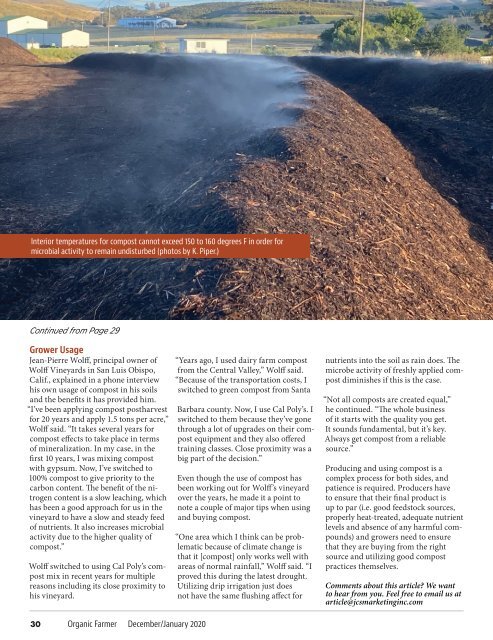OF Dec Jan 2020
You also want an ePaper? Increase the reach of your titles
YUMPU automatically turns print PDFs into web optimized ePapers that Google loves.
Interior temperatures for compost cannot exceed 150 to 160 degrees F in order for<br />
microbial activity to remain undisturbed (photos by K. Piper.)<br />
Continued from Page 29<br />
Grower Usage<br />
Jean-Pierre Wolff, principal owner of<br />
Wolff Vineyards in San Luis Obispo,<br />
Calif., explained in a phone interview<br />
his own usage of compost in his soils<br />
and the benefits it has provided him.<br />
“I’ve been applying compost postharvest<br />
for 20 years and apply 1.5 tons per acre,”<br />
Wolff said. “It takes several years for<br />
compost effects to take place in terms<br />
of mineralization. In my case, in the<br />
first 10 years, I was mixing compost<br />
with gypsum. Now, I’ve switched to<br />
100% compost to give priority to the<br />
carbon content. The benefit of the nitrogen<br />
content is a slow leaching, which<br />
has been a good approach for us in the<br />
vineyard to have a slow and steady feed<br />
of nutrients. It also increases microbial<br />
activity due to the higher quality of<br />
compost.”<br />
Wolff switched to using Cal Poly’s compost<br />
mix in recent years for multiple<br />
reasons including its close proximity to<br />
his vineyard.<br />
“Years ago, I used dairy farm compost<br />
from the Central Valley,” Wolff said.<br />
“Because of the transportation costs, I<br />
switched to green compost from Santa<br />
Barbara county. Now, I use Cal Poly’s. I<br />
switched to them because they’ve gone<br />
through a lot of upgrades on their compost<br />
equipment and they also offered<br />
training classes. Close proximity was a<br />
big part of the decision.”<br />
Even though the use of compost has<br />
been working out for Wolff’s vineyard<br />
over the years, he made it a point to<br />
note a couple of major tips when using<br />
and buying compost.<br />
“One area which I think can be problematic<br />
because of climate change is<br />
that it [compost] only works well with<br />
areas of normal rainfall,” Wolff said. “I<br />
proved this during the latest drought.<br />
Utilizing drip irrigation just does<br />
not have the same flushing affect for<br />
nutrients into the soil as rain does. The<br />
microbe activity of freshly applied compost<br />
diminishes if this is the case.<br />
“Not all composts are created equal,”<br />
he continued. “The whole business<br />
of it starts with the quality you get.<br />
It sounds fundamental, but it’s key.<br />
Always get compost from a reliable<br />
source.”<br />
Producing and using compost is a<br />
complex process for both sides, and<br />
patience is required. Producers have<br />
to ensure that their final product is<br />
up to par (i.e. good feedstock sources,<br />
properly heat-treated, adequate nutrient<br />
levels and absence of any harmful compounds)<br />
and growers need to ensure<br />
that they are buying from the right<br />
source and utilizing good compost<br />
practices themselves.<br />
Comments about this article? We want<br />
to hear from you. Feel free to email us at<br />
article@jcsmarketinginc.com<br />
30 Organic Farmer <strong>Dec</strong>ember/<strong>Jan</strong>uary <strong>2020</strong>


















